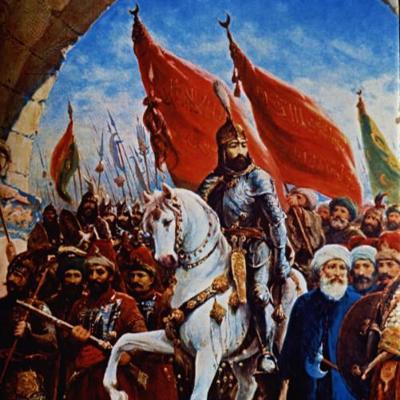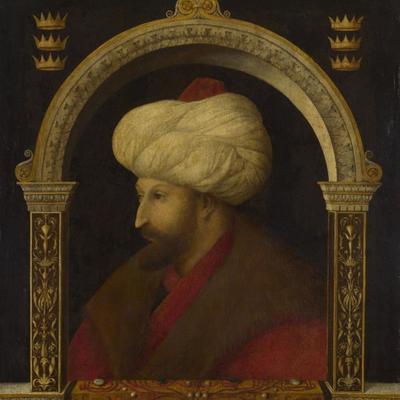A ticket to Ottomans Era
The Conquest of Constantinople is a turning point in history, leading to the Middle Age's end. Sultan Mehmet II was 21-22 years old. As a regular in Ottoman administration, he had a mentor who was Akshamsaddin. Sultan Mehmet II organized several expeditions to conquer Constantinople.
On one occasion, the Ottoman were defeated. Then Akshamdaddin wrote a letter to Sultan Mehmet II.
According, to his letter, Akshamsaddin suggests changing the admiral.1 He consulted the Qur’an to know what to do for the next steps.2 The verses are about the hypocrites who broke their promise and did not support the Prophet Muhammed.3After two defeat (on land and sea), the fleet was demoralized, and rumors began to spread.4 Therefore, Akshamsaddin highlights the importance of unity among the soldiers and notes that “the final decision is in the hands of Allah alone, but it is equally important not to hold oneself back from making the greatest possible effort. This is the example that the Prophet and his companions gave us.” It gave solace to Akshamsaddin.5
nbo12345nbo
5 chapters
16 Oct 2020
The Conquer of Constantinople
May 10, 1470
|
Istanbul
The Conquest of Constantinople is a turning point in history, leading to the Middle Age's end. Sultan Mehmet II was 21-22 years old. As a regular in Ottoman administration, he had a mentor who was Akshamsaddin. Sultan Mehmet II organized several expeditions to conquer Constantinople.
On one occasion, the Ottoman were defeated. Then Akshamdaddin wrote a letter to Sultan Mehmet II.
According, to his letter, Akshamsaddin suggests changing the admiral.1 He consulted the Qur’an to know what to do for the next steps.2 The verses are about the hypocrites who broke their promise and did not support the Prophet Muhammed.3After two defeat (on land and sea), the fleet was demoralized, and rumors began to spread.4 Therefore, Akshamsaddin highlights the importance of unity among the soldiers and notes that “the final decision is in the hands of Allah alone, but it is equally important not to hold oneself back from making the greatest possible effort. This is the example that the Prophet and his companions gave us.” It gave solace to Akshamsaddin.5

The city walls were defenseless, but there was a chain that surrounds from Sirkeci to Galata.6 It prevents the navy from reaching Halic (an inlet of Constantinople). Sultan Mehmet II had a brilliant plan: carrying the ships through the forest to land on water from a different site.7 Sledges were prepared from trees and oiled to slide the sleds easily.8 While these preparation were going on, the Ottoman soldiers kept busy on the chain side to be cautious.9 Once it was completed, 67 or 72 ships carried through that path and landed on water.10 The blockade lasted for 54 days, and after the last attack, the city conquered by Ottomans.11
When Sultan Mehmet II enter the city, he ordered to soldiers not to plunder and damage anything in the city because he declared that Romans were under the auspices of him. 12
It was an Ottoman principle to be tolerant and maintaining peace in the cities. Sultan Mehmet II emphasized the constructions such as Topkapi Palace, Grand Bazaar, and Kulliye. All of these constructions are still some of the most visited sites in Istanbul (Turkey).


Notes
1-5. Sheik Aq Šems ed-Dîn to Mehmet II, 20 April 1452, in La Caduta di Constantinopoli I: Fondazione Lorenzo Valla. ed. Agostino Pertusi. trans. W. North, (Milan: Mondadori 1976).
6-12. Ismail Hakki Uzuncarsili, Osmanli Tarihi: Anadolu Selçukluları ve Anadolu Beylikleri hakında bir mukaddime ile Osmanlı Devleti'nin kuruluşundan İstanbul'un fethine kadar, Vol. 4, (Ankara: TTK, 2015), https://www.ttk.gov.tr/tarihveegitim/istanbulun-fethi/.
Bibliography
1. Fortress built by Ottoman Sultan Mehmed II the Conqueror; walls and Golden Gate built by Emperor Theodosius I; later massive fortification built by Emperor Theodosius II. Current fortress built circa 1457-1458 on 13th-15th century ruins; walls and gates built 4th-5th century AD, Image: April, 2010. Seven Towers Fortress / Yedikule Fortress. https://library-artstor-org.eznvcc.vccs.edu:2443/asset/ASITESPHOTOIG_10313843918.
2. Gentile Bellini, active about 1460; died 1507. 1480. The Sultan Mehmet II. Place: The National Gallery, London, Layard Bequest, 1916. https://library-artstor-org.eznvcc.vccs.edu:2443/asset/ANGLIG_10313768387.
3.Mohammed II, Entering Constantinople. Photo. Encyclopædia Britannica ImageQuest. Accessed Oct 16, 2020.
https://quest.eb.com/search/109_223706/1/109_223706/cite.
4. Sheik Aq Šems ed-Dîn. La Caduta di Constantinopoli I: Fondazione Lorenzo Valla. Edited by. Agostino Pertusi. Translated by W. North. Milan: Mondadori 1976.
5. Uzuncarsili, Ismail Hakki. Osmanli Tarihi: Anadolu Selçukluları ve Anadolu Beylikleri hakında bir mukaddime ile Osmanlı Devleti'nin kuruluşundan İstanbul'un fethine kadar. Vol. 4. Ankara: TTK, 2015. https://www.ttk.gov.tr/tarihveegitim/istanbulun-fethi/.
Share your travel adventures like this!
Create your own travel blog in one step
Share with friends and family to follow your journey
Easy set up, no technical knowledge needed and unlimited storage!